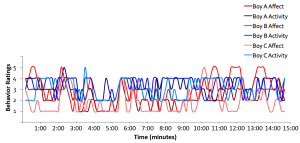Sex and gender mark individual differences in multiple factors, including genes, hormones, socialization, and life experiences. Thus, the study of sex and gender can provide insight into the sources of variation in all of human behavior and speak to the mechanisms underlying potential gender-related disparities. For example, girls’ interest in science, technology, engineering, and mathematics careers is associated with prenatal androgens via the psychological mechanism of interest in things versus people (Beltz, Swanson, & Berenbaum, 2011), gender differences in children’s play depend on the temporal dynamics underlying play behaviors (Beltz, Beekman, Molenaar, & Buss, 2013), and gender plays an important role inks between the adolescent brain and substance use (Heitzeg, Hardee, & Beltz, 2018).

Example of a behavioral time series, showing how the positive affect and vigor of activity of 3 boys changes during a free play session. Connectivity analyses of these data revealed that current levels of vigor of activity were more important for explaining the play of boys than girls, and that past levels of positive affect were more important for explaining the play of girls than boys (Beltz, Beekman, Molenaar, & Buss, 2013).


